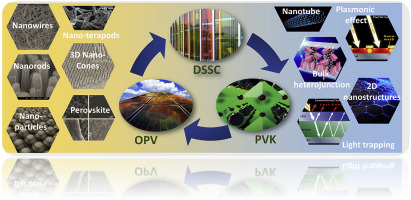Nano Energy ( IF 16.8 ) Pub Date : 2020-01-18 , DOI: 10.1016/j.nanoen.2020.104480 Congcong Wu , Kai Wang , Munkhbayar Batmunkh , Abdulaziz S.R. Bati , Dong Yang , Yuanyuan Jiang , Yuchen Hou , Joseph G. Shapter , Shashank Priya

|
Next generation photovoltaics such as dye sensitized solar cells, perovskite solar cells and organic solar cells, generally referred to as the “third-generation photovoltaic technologies”, will have a great impact on the global deployment of photovoltaic technology. Generally, these photovoltaic cells are layered-structure devices, consisting of nanostructured layers with multiple functionalities comprising of charge collection, extraction and photoconversion. Nanostructured layers including anode/cathode buffer layers, interfacial modification layers, and photon active layers are synthesized by various physical and chemical deposition techniques, which are discussed in this paper. Due to multiple coupling effects in these nanostructured materials as discussed here, the layered cells have great potential for enhanced photovoltaic efficiency. Advanced nanotechnology fabrication approaches have accelerated the design and development of novel nanostructured materials, which is driving the advancements in solar cell performance. The nanomaterials and nanostructures critically impact the optical and electronic properties of the functional layers by modulating their morphology, microstructure, and surface states; thereby influencing the output voltage and conversion efficiency. In this review, we provide a detailed discussion on recent developments in nanostructured materials and illustrate the designs for their integration with “third-generation photovoltaic technologies”. A comprehensive discussion is provided on the role of nanostructures, functionalities, and effectiveness of various nanomaterials in improving the performance of dye sensitized solar cells, perovskite solar cells and organic solar cells. Throughout the review, discussions are included on addressing the remaining challenges and research opportunities.
中文翻译:

用于下一代光伏的多功能纳米结构材料
染料敏化太阳能电池,钙钛矿太阳能电池和有机太阳能电池等下一代光伏技术,通常被称为“第三代光伏技术”,将对光伏技术的全球部署产生重大影响。通常,这些光伏电池是分层结构的设备,由具有多种功能的纳米结构层组成,这些功能包括电荷收集,提取和光转换。通过各种物理和化学沉积技术合成了包括阳极/阴极缓冲层,界面改性层和光子活性层在内的纳米结构层,本文对此进行了讨论。由于在此讨论的这些纳米结构材料中的多重耦合效应,层状电池具有提高光伏效率的巨大潜力。先进的纳米技术制造方法加快了新型纳米结构材料的设计和开发,这正在推动太阳能电池性能的进步。纳米材料和纳米结构通过调节其形态,微观结构和表面状态,严重影响功能层的光学和电子性能。从而影响输出电压和转换效率。在这篇综述中,我们提供了有关纳米结构材料最新发展的详细讨论,并说明了其与“第三代光伏技术”集成的设计。提供了有关纳米结构,功能和各种纳米材料在改善染料敏化太阳能电池性能方面的作用的全面讨论,钙钛矿太阳能电池和有机太阳能电池。在整个审查过程中,讨论都涉及解决剩余的挑战和研究机会。









































 京公网安备 11010802027423号
京公网安备 11010802027423号